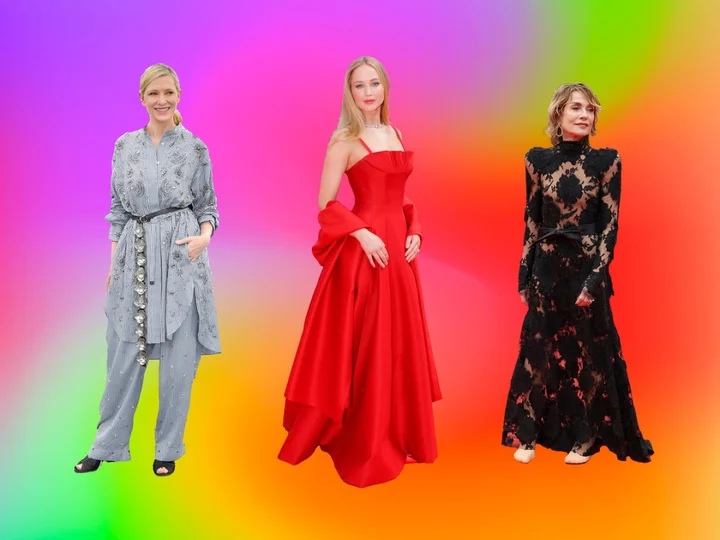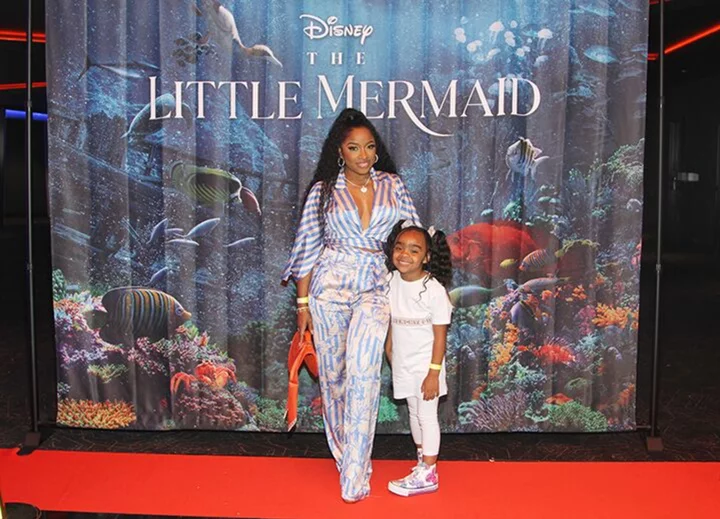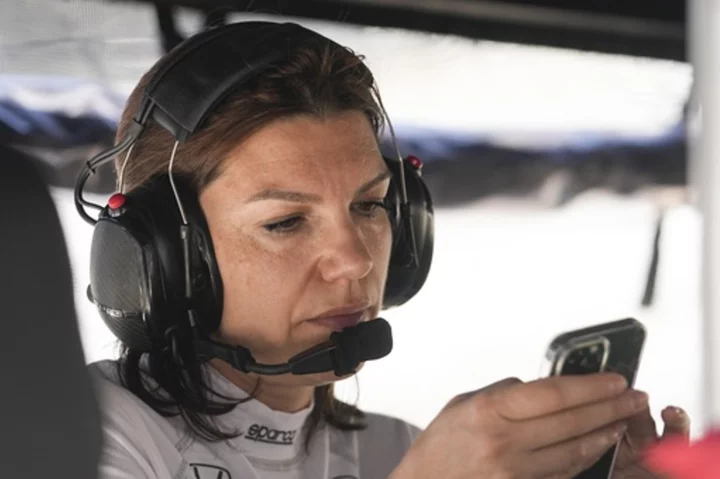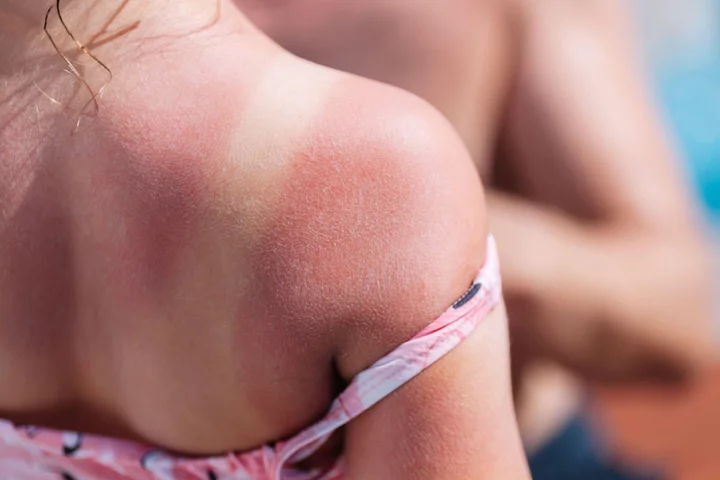
Flip-flops, nudity and ‘up the vajayjay!’: How the red carpet became a platform for protest
Of all the places you’d expect to see a woman walking barefoot, the red carpet at the Cannes Film Festival is probably not one of them. And yet, this has become a somewhat regular occurrence at the annual shindig, where A-list actors, models and directors gather in their finest gladrags. Sure, the festival is ostensibly about celebrating the best of cinema. But it has also become one of the most significant events in the fashion calendar, with stars taking the opportunity to make both sartorial and political statements. However, out of all the trends that have prevailed, from cutout gowns to sheer sequins, the one that continually seems to trump them all is none other than women’s feet. And it’s already made headlines again this year, thanks to the likes of Natalie Portman, Jennifer Lawrence and Isabelle Huppert, all of whom have made their own subtle nods to the political powers of their own feet. Traditionally, the Cannes dress code is rather strict: in 2015, a group of women in their fifties were reportedly turned away from a screening because they were wearing “rhinestone flats” instead of high heels. The story immediately prompted a backlash and accusations of sexism, with the festival’s director, Thierry Frémaux, denying that heels are mandatory: “The rumour saying the festival insists on high heels for women on the red carpet is unfounded,” he wrote in response to critics on Twitter. Nonetheless, female actors were quick to respond, with Emily Blunt saying at the time: “Everyone should wear flats, to be honest. We shouldn’t wear high heels.” The following year, Julia Roberts and Sasha Lane attended Cannes events barefoot. “The carpet was for our film and I was dressed in a very elegant gown and there’s a ton of stairs, and I’m walking around all day… so I will go barefoot,” Lane said in a later interview. “Why is anyone against that? I’m still here and well-dressed.” Lane’s comments were also echoed by Kristen Stewart, who once said of strict female dress codes: “I feel like you can’t ask people that anymore. If you’re not asking guys to wear heels and a dress, you cannot ask me either.” The Twilight star famously took off her sky-high Christian Louboutin heels on the red carpet at Cannes in 2018, proceeding to walk the rest of the carpet barefoot. Official rule or not, there’s no mistaking that even now, in 2023, the pressures placed on women at black tie events such as Cannes are different to those placed on men. Sartorial convention has long defined occasionwear as anything that leaves your feet uncomfortable. Whether it’s a pump, sandal, or stiletto, the shoe needs to add some sort of height to your look in order to be considered formal and appropriate. It might seem like a small imposition, but if there’s anything this year’s red carpet has taught us, it’s that it can serve as a microcosm of much wider inequalities. Take Cate Blanchett, who last weekend at a Cannes party presented an award to the French-Iranian star Zahra Amir Ebrahimi. “I am going to take my heels off, in honour of the women of Iran,” she told the crowd, before holding up Ebrahimi’s pointed trophy to joke: “This is to stab everyone who stands in the way of women’s rights. Up the vajayjay!” The sentiment has also been referenced by Portman, Lawrence and Huppert at this year’s festival. On Saturday, while talking about her new film May December, Portman spoke about the idea of “performing femininity”, telling attendees that it’s something she’s “very curious about”. “The different ways that we as women are expected to behave – at this festival, even – compared to men,” she said. “How we’re supposed to look, how we’re supposed to carry ourselves.” Meanwhile, Lawrence arrived on the red carpet for the Bread and Roses premiere in a scarlet Dior gown paired with flip-flops. And as for Huppert, a perennial style maven at Cannes and beyond, she made a subtle nod to the shoe-less protests in a pair of Balenciaga heels that had been specially designed to resemble a bare foot. All this serves as a reminder that despite societal progressions, women’s bodies are still firmly policed in the public eye. If it’s not via their footwear, it’s via their actual outfits. Think supermodel Irina Shayk, whose outfits at Cannes events this year include a leather two-piece by Mowalola that exposed her entire torso, and a sheer black dress worn over a matching set of Gucci underwear. Elsewhere, we’ve seen Julia Fox don a completely see-through bodice with a white flowing skirt, while Naomi Campbell walked the red carpet in a scarlet gown with cutouts across her chest. Showing skin is nothing new among the fashion set, particularly given the resurgence of Y2K trends on the runways that continues to maintain its stronghold on the industry. (There has been talk of “naked dresses” for several seasons now, with influencers and stars all partaking in the art of wearing sheer gowns to formal affairs.) But bringing it to Cannes feels particularly poignant and in keeping with the barefoot brouhaha when you consider just how easily offended people are by such ensembles. The body-shaming prompted by Florence Pugh’s see-through Valentino frock last summer is just one example that springs to mind. Flashing a foot is, of course, somewhat different to flashing a nipple, but fundamentally the underlying message is the same. It’s about subverting the social conventions that oppress us. It’s about showing the world that women are fed up of being told what is and is not an acceptable way of presenting their bodies. And it’s about asking why we should still conform to dress codes informed by sexism when, as Blanchett pointed out, women’s rights continue to be subjugated around the world. With all this in mind, we’re not asking for much. The least people can allow us is to take off our heels or flash a little flesh without it having to be headline news. Read More Subversive? Dangerous? Boring?: How the red carpet became a barometer for modern masculinity Hostage to fashion: Margot Robbie’s Chanel problem speaks to a wider red carpet crisis Can casual sex ever really be casual? All the best-dressed stars at the 2023 Cannes Film Festival Jennifer Lawrence stuns at Cannes Film Festival in red Dior gown - and flip-flops Amber Heard supporters react to Johnny Depp’s Cannes welcome
2023-05-27 14:17

A Southwest pilot had to crawl into the cockpit window after the flight deck door was locked
It's never fun to be locked out -- whether it's from your house, your car, or a commercial airliner.
2023-05-27 02:50

Wall Street Looks to ‘Little Mermaid’ to Stoke Theater Rally
A rally in movie-theater operators will be put to the test as the debut of Walt Disney Co.’s
2023-05-27 01:53

Over more than 100 years, 9 women have raced the Indianapolis 500 and the push for more has stalled
Katherine Legge remembers her days as a youngster driving go-karts and how at times she was ruthlessly bullied by the boys
2023-05-26 23:20

When Tina Turner Set a Guinness World Record
On January 16, 1988, Tina Turner performed for approximately 188,000 fans at Maracanã Stadium in Rio de Janeiro, Brazil—and made history.
2023-05-26 22:27

Taylor Swift Fans Have to Barter, Borrow and Plead to Get Into Her Shows
For Taylor Swift fans, 52 concerts in massive football stadiums were never going to be enough to satisfy
2023-05-26 20:22

Bank holiday heatwaves predicted: 6 sunburn myths that could put you at risk
After a largely disappointing spring, the bank holiday weekend is set to bring with it the warmest weather of the year so far. Temperatures are predicted to go as high as 24C on Saturday and Sunday, according to the Met Office, with dry and sunny weather expected to last into next week. Many of us will be heading out to enjoy the sunshine – but as ever, it’s important to protect your skin from harmful UV rays. When it comes to tanning and sunburn, there are a variety of misconceptions that still abound, and the consequences of not following sun protection advice can be severe – especially as skin cancer rates across the UK have been rising, charities have warned. Here are five sunburn myths that could be putting your health at risk… 1. The UK and Irish sun isn’t strong enough for sunburn We might grumble about the gloomy weather in our part of the world, but the risk of sunburn remains for a large part of the year. “The sun can be strong enough in the UK between mid-March and mid-October to burn you,” says Karis Betts, senior health information manager at Cancer Research UK, which is working in partnership with Nivea Sun to educate consumers on how to be sun safe. “You’re most likely to get burnt in the middle of the day, when the sun is at its highest point, not necessarily its hottest.” UV rays are generally strongest between 11am and 3pm, she says: “It’s wise to take a break in the shade or indoors during these hours. And remember, you can burn through clouds.” 2. You have to go red before you go brown Our complexion can turn darker in the sun due to the release of melanin as the skin attempts to protect itself, but that doesn’t mean you need to turn lobster-red first in order to try and get a tan. “This is one of the biggest myths in sun protection, and it contributes to skin damage and skin cancer cases,” says Abi Cleeve, MD of Ultrasun UK. “The fact is that as soon as the skin reddens, it’s in trauma. A ‘trauma tan’ occurs from inadequate protection where the skin appears to tan more quickly, but hasn’t – it has burned. This only ensures that the skin peels, leaving the skin tan-less in days.” To avoid this pattern, Cleeve recommends gradually building up your time in the sun, and using higher SPF sunblock: “Use high UVA and UVB filter SPF – a minimum of SPF30 with a UVA filter over 90% will protect the skin and still tan, just more slowly [and] minimising long-term damage and peeling.” 3. The odd sunburn doesn’t make a difference It’s easy to get caught out by a sudden blast of sunshine, but don’t be fooled into thinking that one instance of sunburn here and there doesn’t matter. “This is something I hear a lot but unfortunately, it’s just not true,” says Betts. “Damage to our skin from the sun is the number one cause of melanoma, the most serious type of skin cancer, and skin damage from the sun builds up over time – it doesn’t go away after the burn fades.” That’s why wearing sunblock is crucial – even more so for children. According to the Skin Cancer Foundation: “Even one blistering sunburn in childhood or adolescence more than doubles your chances of developing melanoma later in life”. 4. People with darker skin don’t get sunburnt “Anyone can get sunburnt – including people with darker skin – but your risk of getting sunburnt and how sunburn feels will depend on your skin type,” says Beth Vincent, health information manager at Cancer Research UK. “For people with lighter skin tones, sunburned skin is usually red, sore, and swollen. In people with darker skin tones, sunburned skin might not change colour but will often feel irritated, itchy, tender and sore.” While people with lighter skin tones are generally at higher risk of sunburn and skin cancer, you should still use sunblock if you’ve got darker skin or a tan. In terms of sunscreen for darker skin tones, Betts recommends: “At least SPF15 and four or five stars [for UVA protection]. Make sure to reapply it regularly and generously, especially after swimming, sweating or towelling.” 5. All body parts are created equal when it comes to sunscreen “Burning – overexposure to UVB rays – tends to happen where the skin is closer to the bone structure, and especially where the part of the body faces directly the sun’s rays,” says Cleeve. “Tops of feet, shoulders, décolleté, top of the scalp and the nose – take extra care in these areas.” Other easy-to-miss areas include the scalp or parting, ears, areas around swimwear such as straps, and shorts that might move or rise up through the day. Cleeves top tip for all-over protection? “Do your sun cream naked! Then any movement in straps, shorts won’t suddenly bare unprotected skin to the sun’s rays.” 6. Aftersun products repair the damage done by sunburn “No, they don’t,” says Vincent. “While aftersun products may soothe the unpleasant symptoms of sunburn, they won’t fix any damage that was done to the DNA inside your cells.” If you do start to notice signs of burning, cover up or get out of the sun as soon as possible, she warns: “Don’t spend more time in the sun that day – even with sunscreen. And don’t rely on aftersun to fix the damage, because it can’t.” Read More Charity boss speaks out over ‘traumatic’ encounter with royal aide Ukraine war’s heaviest fight rages in east - follow live Dame Esther Rantzen faces stage four lung cancer: key facts about the disease Camilla receives ‘beautiful’ compliment after meeting children at historic library 7 foods that could help you get better sleep
2023-05-26 19:57

Australian man’s DNA test reveals he’s related to Kate Middleton: ‘We both have smashing smiles!’
An Australian man, who discovered he is a distant relative of the Princess of Wales through an AncestryDNA test, has said they both have the same “smashing smiles” and “great dress sense”. David Willis, 54, a union organiser, who lives in Avenel in Victoria, Australia, with his partner of 18 years, Rodney Kendall, 52, found out, in 2017 after doing the DNA test, that he is Kate’s fourth cousin once removed through his mother’s working class family from Durham in the UK. David, whose friends now call him a “queen”, has also tracked down a fourth cousin in Durham who he speaks to regularly via email – he hopes to one day meet her in person, and joked he might “extend (his) invitation to Kate”. But, despite the genetic evidence, David’s mum “still won’t believe him”, as she “always understood (their) roots to be working class”, but his cousins “are loving” the royal connection. On David’s father’s side, he has discovered that “they were a boat full of convicts”, so he now likes to jokingly refer to himself as “Kate’s convict cousin”. “I thought, what do Kate Middleton and I have in common? We both have smashing smiles, great dress sense and we’re distant cousins,” David said. “I have blue blood – my friends call me a queen – I truly am!” David began researching his family history more than 20 years ago, he explained: “I’m a bit of an amateur historian. “When Ancestry started – I’ve been involved for probably 18 to 19 years – I was able to access materials, resources and documents that in the past I would have had to have travelled to England to gain access to, so I was able to do that all online. “I researched my family on both sides, and that’s when it came up with an interesting connection.” In 2017, it appeared as if Kate was on David’s family tree, he said: “No one believed me – I had to double check the paperwork, and I thought what better way of doing it than testing my DNA through Ancestry. “I was able to just submit my DNA to finally prove and say to everybody that I got my research right.” It was confirmed that David’s mother’s working class family, from Durham in the UK, had links to Kate – they are fourth cousins once removed. David explained their connection: “We share a common ancestor, and we’re fourth cousins once removed. “We go back six generations and Kate goes back seven to our common ancestor, Jane Conyers, who was the daughter of a fellow called Sir Thomas Conyers, the ninth Baronet of Horden. “But, because he had three girls, the title died off with him and they married the local folk in the town. “So one of those girls was called Isabella, and her sister was called Jane. “About six generations ago, when my family sort of fell out of royalty with Sir Thomas, the rest of them were working in the coal mines – I find that fascinating stuff.” David has also discovered a third cousin, the daughter of his great-grandfather, who lives in Durham. He said: “We’ve actually been talking by email for probably one and a half years now, every couple of weeks. “She’s all excited about our family’s story. “And she did her DNA test too, and she’s definitely also related to Kate.” David explained how his family in Australia feel about being related to Kate: “My mother just doesn’t want to know – she doesn’t believe it because our family were always understood to be very working class. “Our family comes from Durham in the north, and my grandfather and his mother emigrated to Australia, after World War One, when my great-grandfather was killed. “He was a coal miner from Newcastle upon Tyne, so my family escaped poverty by moving to Australia, and we just always understood our roots to be working class. “So when there was a bit of a royal connection I don’t think we quite knew how to feel. “Mum still won’t believe me, but my cousins are loving it.” David explained how it feels to have a link to the current royal family: “I’m not a massive royalist by any means, because, in Australia, we’re a few steps removed. “But having said that, I still have a fascination with UK culture – I watched every bit of the coronation for example.” David explained the stark contrast between his mother’s and his father’s side of the family: “On my mum’s side we have sirs and Kate Middleton, but on my dad’s side, on the other side of the world, they were a boat full of convicts, so I joke that I’m Kate’s convict cousin!” Looking to the future, David hopes to meet some of his closer relatives in the UK, he explained: “I’d love to meet the cousin I’ve been emailing and have a trip to Durham. “Maybe I’ll also extend my invitation to Kate and see if she fancies joining!” Read More Kate Middleton sticks to royal protocol after fan asks for an autograph: ‘I can’t write my name’ ‘I did a DNA test and found out I had 7 siblings I didn’t know about’ Kate Middleton has touching response after child asks what it’s like to be a princess Charity boss speaks out over ‘traumatic’ encounter with royal aide Ukraine war’s heaviest fight rages in east - follow live
2023-05-26 18:57

Dame Esther Rantzen faces stage four lung cancer: key facts about the disease
Dame Esther Rantzen has revealed that her lung cancer has progressed to stage four, after previously announcing in January that she had been diagnosed with the disease. The Childline founder and broadcaster told The Mirror that “nobody knows” if the new medication she is trying is working and a scan “will reveal one way or another”. Earlier in the year, Rantzen, 82, said she had “decided not to keep this secret any more because I find it difficult to skulk around various hospitals wearing an unconvincing disguise” and was “remaining optimistic”. Stage four is when cancer has spread from where it started to another body organ, according to Cancer Research UK, and is also called secondary or metastatic cancer. More than 43,000 people are diagnosed with lung cancer every year in the UK, according to the NHS, making it one of the most common forms of cancer – yet the disease is often shrouded in myths and misconceptions. So, what do you need to know? Here are some important facts about lung cancer… 1. Lung cancer can affect people of any age According to John Costello, a pulmonologist at the Mayo Clinic: “Lung cancer is certainly more common in older people – the average age of diagnosis is 70 years.” This does not mean it only ever affects older age groups, however. Lisa Jacques, lead specialist cancer nurse at Perci Health, says: “Most people develop lung cancer in their 60s and 70s, after many years of smoking, but occasionally people get lung cancer at a much younger age, even in their 20s and 30s.” 2. Lung cancer is not always caused by smoking Although smoking can certainly increase your chances of developing lung cancer, it is not the only cause. “Smoking is the cause of most lung cancers and the biggest risk factor, but about 10% of people who get lung cancer have never smoked,” explains Jacques. Costello adds: “There are some lung cancers which are genetic and may not be smoking-related, and some others are caused by exposures to substances like asbestos, radon gas and passive smoking” – although he says these are “relatively uncommon”. 3. Stopping smoking can help protect you Costello says: “Some of the damage and inflammation caused by smoking can be reversible, but in particular, emphysema is architectural destruction of the lung which causes extreme breathlessness and cannot be reversed.” So quitting smoking might reduce your risk and is always worthwhile for your health – but not starting the habit at all is much better. Speak to your GP if you would like support with quitting. 4. Lung cancer is not always deadly A diagnosis of lung cancer does not always mean certain death, but it is still serious. “Lung cancer has a 65% survival rate for five years in people with localised disease,” says Costello. “If it has spread around the body at the time of diagnosis, the survival rate is only 8%.” However, he says there are “new techniques in screening for lung cancer, such as CT scans in smokers over 50 years with a serious tobacco background”. These “may pick up very small early tumours, which can be removed with up to an 80-90% five-year survival rate”. So if you have concerns about a persistent cough, which is one of the key warning signs, see your GP and get it checked out as soon as possible. 5. Men are more likely to get it but women still need to be aware According to Cancer Research UK, men are more likely to get the disease than women (52% of lung cancer cases are men, compared to 48% of women). However, these margins are small, and women absolutely do need to be aware of lung cancer as well. “Lung cancer has been an increasing problem in women since they caught up with men in terms of smoking habit, and they are therefore at risk if they smoke, and some of the non-smoking related lung cancers are more common in women,” says Costello. Jacques adds: “It is the third most common cancer in the UK, and in women it is the second most common cancer type.” So, whether you smoke or not, look out for the symptoms of lung cancer – like a cough lasting longer than two or three weeks, recurring chest infections, breathlessness or aches and pains when breathing – and see your GP if you have any concerns. Read More Charity boss speaks out over ‘traumatic’ encounter with royal aide Ukraine war’s heaviest fight rages in east - follow live Camilla receives ‘beautiful’ compliment after meeting children at historic library 7 foods that could help you get better sleep Household energy bills set to fall from July: 7 ways to help keep bills as low as possible
2023-05-26 18:45

A $189 Airport Travel Hack Is No Longer Working Very Well
Few things are more tiresome than slowly shuffling forward in an airport line with one anxious eye on
2023-05-26 18:16

Woman’s ‘$1,300’ designer dress divides the internet: ‘You got scammed’
A designer dress apparently worth US$1,300 has been criticised as looking “cheap” after a woman posted a video of herself styling it on Instagram. Marjan Tabibzada, a fashion influencer whose Instagram account @youngcouture_ has more than 1.2m followers, shared the clip featuring a pink sheer dress by Jacquemus that currently retails for £970. The silk chiffon maxi dress features a cowl neck and strap detailing, as well as a flowing skirt with a train. Viewers, however, were unimpressed by how the dress looked and criticised it for appearing “cheap” and “not worth” the price tag. In her video, Tabibzada said she purchased a pink slip dress from Amazon to wear underneath the Jacquemus dress because it was “way too see-through”. She accessorised with flowery pink earrings, strappy heels from Zara, and a pearl clutch from Los Angeles brand Cult Gaia. In her caption, Tabibzada wrote: “Is this dress worth US$1,300?” Many of her viewers did not think so, with some saying that the influencer “got scammed” into buying the garment. “Definitely not worth the price… US$13 sure but I wouldn’t even spend US$20 on that,” one person said. A disappointed follower wrote: “Why is it so bad though? I had high hopes.” Explaining why they didn’t like the dress, one person said: “Not in love with the dress, especially with the tag showing through due to the sheerness. I don’t get the concept they were going for.” Another said the dress was “giving Shein”, comparing the designer garment to those sold on the fast fashion online retailer. Others defended the dress and its price, highlighting that it is made with luxury fabrics. One person wrote: “People in the comments are foolish, ‘Looks like it’s from Shein’, OK, great, enjoy your $9 (£7) dress. Expensive fabrics typically feel so incomparable on the body. “It won’t be staticky, it probably doesn’t stain as easily or snag… Y’all really think Shein dresses lok like real clothes… I think it’s very elegant. I’ll never understand the fascination with cheap clothes and shoes for some, they don’t feel the same.” Read More Mother reveals the sweet meaning behind viral graduation gift for her daughter Influencer hospitalised for traumatic brain injury after horse falls on her at Arizona ranch Beyoncé’s Renaissance mirror-ball cowboy hat has sold out – but we’ve found some similar styles Exposed bras are the newest fashion trend, but not everyone is convinced All the best-dressed stars at the 2023 Cannes Film Festival Italian designer launches scathing attack on Shein over ‘stolen ideas’
2023-05-26 16:59

We're still waiting for self-driving cars, but autonomous boats are already here
From cargo ships to passenger ferries, self-driving boats are already making a splash on our waterways.
2023-05-26 16:55
